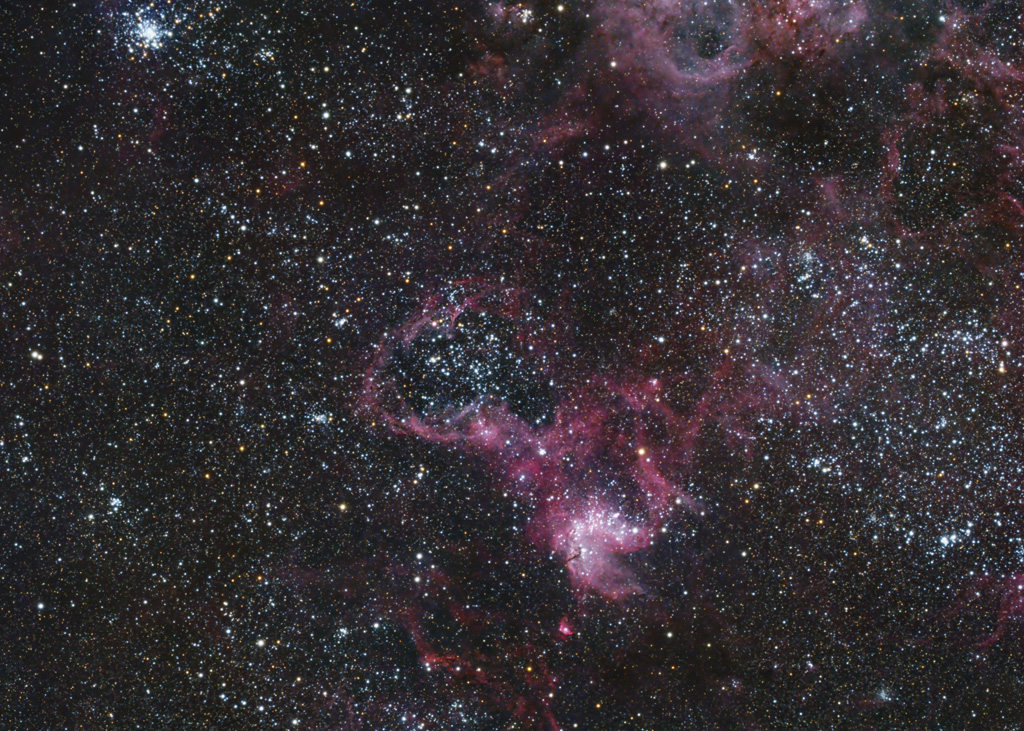 |
CHAMÄLEON + ONJALA OBSERVATORY DeepSky | SITEMAP HOME CHAMÄLEON |
|
 |
|||
| « zurück zur Startseite
galaktische Nebel « back to home galactic nebula |
Großes Bild laden - load large
image 2048 x 1400 Pixel Aufnahmedaten Image data |
NGC 1761, NGC 1763 and NGC 1796 - Star formation in the Large Magellanic Cloud

NGC 2074 und NGC 2081 - Unser Bild zeigt eine weitere Sternentstehungsregion in der großen Magellanschen Wolke im Detail, aufgenommen im Mai 2023. Die beiden Objekte NGC 2074 und NGC 2081 sind als offene Sternhaufen, umgeben von Emissionsnebeln, klassifiziert. Sie liegen nur ein knappes halbes Grad direkt südlich des Tarantelnebels NGC 2070.
Die Sternentstehungsregionen in der Magellanschen Wolke sind deutlich größer als die in unserer Milchstraße. So überdecken die beiden Objekte im Bild eine wahre Größe von etwa 1.000 Lichtjahre. Im Vergleich dazu hat die Region NGC 3603 in unserer Milchstraße nur einen Durchmesser von 400 Lichtjahre und der berühmte Orionnebel bringt es nur auf 40 Lichtjahre. Ebenfalls findet man in der Magellanschen Wolke die Blasen, die sich um die großen Sternhaufen gebildet haben, wie hier z.B. in Bildmitte um NGC 2081, im Vergleich zur Milchstraße deutlich häufiger.
NGC 2074 wurde übrigens als Objekt für eine Aufnahme des Hubble Space Teleskops während des 100.000 Orbit um die Erde am 10. August 2008 gewählt.
Object description
NGC 2074 and NGC 2081 - Our image shows another star-forming region in the Large Magellanic Cloud in detail, taken in May 2023. The two objects NGC 2074 and NGC 2081 are classified as open star clusters surrounded by emission nebulae. They lie just under half a degree directly south of the Tarantula Nebula NGC 2070.
 |
The star-forming regions in the
Magellanic Cloud are significantly larger than those in our Milky Way. The two
objects in the image cover a true size of around 1,000 light years. In
comparison, the region NGC 3603 in our Milky Way has a diameter of only 400
light years and the famous Orion Nebula is only 40 light years across. The
bubbles that have formed around the large star clusters in the Magellanic
Cloud, such as here around NGC 2081, are also much more common than in the
Milky Way.. By the way, NGC 2074 was chosen as the object for an image taken by the Hubble Space Telescope during its 100,000 orbit around the Earth on August 10, 2008. « Klicken Sie hier oder auf das Vorschaubild zum Laden eines großen Bildes mit Objektbezeichnungen. « Click here or on the thumbnail to load a large image with object annotations. |
NGC 2074 and NGC 2081 - Star formation in the Large Magellanic Cloud
Image data
10.05.2023 - 12 x 300 s, QHY ALccd 12 (cooled)
Telescope: PlaneWave CDK 12.5" Astrograph + 0.8x Reducer at f = 2030 mmm
Location: Chamäleon Observatory, Onjala Lodge, Namibia
Image acquisition and processing: DeepSkyStacker, PixInsight + Photoshop
Coordinates: RA: 04 56 45 - DEC: -66 28 45
 |
 |
 |
 |
 |
 |
 |
| Sonne | Mond | Sonnensystem | DeepSky | Weitwinkel | Verschiedenes | Spez. Projekte |